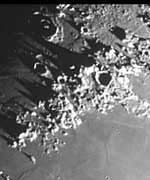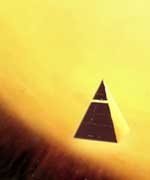
Image credit: Sylvain Weiller
Monday, April 11 – For viewers in Alaska tonight, you will see the Moon will occult Delta Aquarii while in Chile the Moon will occult the Plieades on this universal date. Please consult the webpage for further details.
William Wallace Campbell was born today in 1862. He was a pioneer observer of stellar motions and radial velocities and served as a director of Lick Observatory. 98 years later, the first radio search for extraterrestrial civilizations was started by Frank Drake called Project Ozma and for those of us who were chasing comets in 1986, we were enjoying Halley’s closest approach to Earth on this date. Although it will be hard to best that, for northern observers, the “Magnificent Machholz” is still a large binocular or small telescope object. Skirting along the Draco – Ursa Major border, it has faded to around magnitude 8. For a nightly locator chart, please visit Heaven’s Above.
With only a slender crescent Moon, tonight would be a great time to just relax and enjoy a little skywatching. It’s the peak of the Virginid meteor shower! This shower is a very complex and tangled array of four streams with no clear radiant. While conditions are conducive, it is possible to see up to 30 faint streaks per hour, but this stream is well known for producing bolides.
Tuesday, April 12 – Today Yuri Gagarin became the first man in space making one orbit of the Earth in 1961 onboard Vostok 1. Only 20 years later, Columbia became the first space shuttle to launch. As this historic day stars, why not take the opportunity to look for a distant planet before dawn? Mars will be your guide – and you will find Neptune just slightly more than a degree north.
Let’s view the Moon tonight and locate shallow crater Cleomides just north of Mare Crisium. It is one of the most ancient features on the lunar surface and may be between 4 to 5 billion years old. Although its interior has been flooded by lava, you can still see the punctures of several young craters. For those wishing a challenge, power up to locate Rima Cleomides cutting diagonally across its northern shore.
Wednesday, April 13 – This evening will offer us an opportunity to view a crater that has long been an object of lunar transient phenomena study – Proclus. You will find this small, bright crater on the edge of Mare Crisium. It has a very high albedo (surface reflectivity) and has been known to show unusual brightenings. Depending on how far the terminator has progressed, you may get a glimpse of a highlighted rectangular feature in the shadows of its southeast wall.
Thursday, April 14 – Dutch scientist, Christian Huygens was born today in 1629. We know him as being the first to discover Saturn’s rings and large satellite Titan, but did you know Huygens held the patent for a pendulum clock? The clock ticks as the years go by on this date to reveal catastrophe. President Lincoln was shot in 1865, the Titanic sank in 1912, and who can forget that Apollo 13 met its disaster in 1970?
While today might be “bad luck” for some, it will be our good fortune to see a crater so old and ruined that it’s almost extinct. Start by identifying the three rings of Theophilus, Cyrillus and Catherina. To the south you will see the broad, bright wall of the Altai Scarp and further south a huge shallow crater on the terminator. This crater can only be seen during this particular stage of lunar sunrise and has become so dilapidated that it is unnamed. Younger craters, Lindenau and Rothman invade its northern wall and you will see a small collection of craters to the south that resemble a “paw print”. Enjoy it tonight, for it will be gone tomorrow..
Friday, April 15 – In a wide swath, the Moon will occult open cluster NGC 2331 for observers across Europe. While no specific details are listed for times, you can visit the IOTA map to see where the event will take place. For the San Francisco Bay area, the Moon will deliver a splendid graze of Epsilon Geminorum on this date. Please consult with IOTA to plan for this event. For the rest of us? We’ll see the Moon about five degrees north of Saturn.
Tonight, let’s take a quiet journey on the lunar surface as we view the area highlighted in this week’s photo – the Caucasus Mountains. Easily spotted in both binoculars and small telescopes, this mountain range towers around 5182 meters above the surrounding plains – making its peaks as high as Mount Ararat. As the shadows throw the rugged terrain into bold relief, take the time to enjoy watching the terminator move on the lunar surface. As time passes you can easily note the mountain’s shadows shortening and details emerge in Crater Cassini. It’s a very peaceful experience…
While you are waiting for the sunlight to advance, keep a watch for the “April Fireballs”. This unusual name has been given to what may be a branch of the complex Virginid stream which began earlier in the week. The absolute radiant is unclear, but keep your eyes on the southeastern skies. These bright bolides can possibly arrive in a flurry depending on how much Jupiter’s gravity has perturbed the meteoroid stream. Even if you only see one tonight, keep watching in the days ahead. The time for “April Fireballs” will last for two more weeks!
Saturday, April 16 – Tonight the Moon is furthest (apogee) from Earth at 404,304 km, but a bright star – Pollux will visually appear much closer at slightly more than a degree to the north. For viewers in the southwestern portion of North America, the Moon will occult Epsilon Geminorium on this universal date. Please check IOTA for precise times in your area.
If you explore the lunar surface this evening, you will find a very curious feature known as the Alpine Valley. Located near the terminator in the north, binocular viewers might catch a glimpse of this long, narrow scar that creases through the foothills between Mare Frigorus and Mare Ibrium. Telescopically, it is fascinating. Running a distance of 177 kilometers and ranging between 1.6 to 21 kilometers wide, this gash through the Montes Alpes will show tiny crater Trouvelot to its south and stable conditions at high power will reveal a narrow fissure on its floor. It is speculated this valley was literally carved into the lunar surface as a result of a glancing impact. Enjoy it tonight!
Sunday, April 17 – Are you ready for even more meteors? Tonight is the peak of the Sigma Leonids. The radiant is located at the Leo/Virgo border, but has migrated to Virgo in recent years. Thanks to Jupiter’s gavity, this shower may eventually become part of the Virginid Complex as well. The fall rate is very weak at around one to two per hour, and the presence of the early evening Moon will definitely hamper viewing.
Since we’ve got to deal with the Moon, why not have a look at crater Eratosthenes? Just slightly north of lunar center and on the terminator, this easily spotted feature lay at the end of the Apennine Mountain range. Its rugose walls and central peaks make for excellent viewing.
Until next week? Ask for the Moon… But keep reaching for the stars! May all your journeys be at – Light Speed… ~Tammy Plotner


